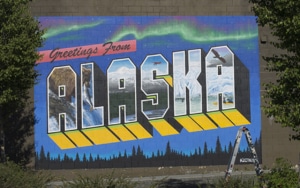On Christmas Day 2020, in the midst of a global pandemic, Netflix debuted “Bridgerton”, a new series based on a collection of novels by author Julia Quinn. The series is set in Regency-Era London during the social season, and revolves around the fictional Bridgerton family. The show got generally good reviews in its first season, and in it’s second season became a worldwide sensation. As with anything or anyone famous these days, this resulted in a number of fan pages and “tributes” on social media sites. Among those was a TikTok tribute by started by fans Abigail Barlow and Emily Bear in early 2021. That fandom grew into a 15 song album, The Unofficial Bridgerton Musical, which was released in September 2021 and won a Grammy Award for best musical theater album in 2022. The songs on that album include verbatim lyrics, plot elements and scenes and characters that are lifted from Netflix’s Bridgerton series.
Then, on July 26, 2022, Barlow and Bear performed a live, for-profit stage show entitled “The Unofficial Bridgerton Musical Album Live in Concert” before a sold out audience at the Kennedy Center in Washington, DC. Three days later, Netflix filed suit alleging copyright infringement and trademark infringement in that Barlow and Bear have “taken valuable intellectual property from the Netflix original series Bridgerton to build an international brand for themselves.”
There can be little argument that the Unofficial Bridgerton Musical album and the live performance are derivative works based on the copyrighted Bridgerton series. Likewise, Barlow and Bear’s use of the term “Bridgerton” in its title, absent some other justification, is clearly a violation of Netflix’s trademark rights, notwithstanding the use of the word “Unofficial”. To hold otherwise would be akin to Ricky Bobby’s argument that he could say whatever he wanted so long as it was prefaced by “with all due respect”.
On it’s face, this would appear to be an open and shut case of copyright and trademark infringement. However, there are at least three legal theories upon which Barlow and Bear could prevail – fair use, latches and estoppel.
Does the Unofficial Bridgerton Musical constitute “Fair Use”
The doctrine of fair use permits limited use of copyrighted material without having to first acquire permission from the copyright holder. Fair use is often applied where the subsequent work is being used for purposes such as criticism, commentary, news reporting, teaching, scholarship or research. Four factors must be considered in determining whether the fair use exception applies:
- The purpose and character of the use, including whether such use is of a commercial nature or is for non-profit educational purposes;
- The nature of the copyrighted work;
- The amount and substantiality of the portion used in relation to the copyrighted work as a whole; and
- The effect of the use upon the potential market for or value of the copyrighted work.
While no one factor alone is determinative, the first and fourth factors are generally given the most weight. Looking at the first factor, the fact that the live performance was for profit makes it less likely to qualify as fair use. Unless the live musical performance can be considered “transformative” – a use that adds something new, with a further purpose or a different character”, the first factor is likely to weigh heavily in favor of Netflix. With regard to the fourth factor, Netflix alleges that the live performance adversely affects its ability to profit from its own planned release of a live event entitled “The Queen’s Ball: A Bridgerton Experience.” Given the commercial nature of the live performance, it is difficult to imagine a court siding with Barlow and Bear on a fair use defense.
Laches and Estoppel – Did Netflix waive its right to object to continued and/or further use?
Even according to the complaint filed by Netflix, they took little more than token efforts to stop the infringing actions of Barlow and Bear for more than a year and a half. The doctrines of laches and estoppel provide for the denial of claims of infringement where the claim is not acted on in a timely manner.
When asked about the impending release of the Unofficial Bridgerton Musical Album in a September 2021 interview, Barlow stated “Ask and you shall receive. Netflix was very, very supportive” suggesting that Netflix may have given permission. Netflix’s own complaint admits that they knew about Barlow and Bear’s Bridgerton inspired TikTok posts as early as December 2020. Although Netflix alleges that they repeatedly told Barlow and Bear that their works were not authorized, Netflix did nothing to stop those unauthorized works until after the live musical performance in July 2022. The complaint specifically states that Netflix believed that it “would be consulted before Barlow & Bear took steps beyond streaming their album online in audio-only format.” Is that an acknowledgement of permission? Time will tell.
How will the outcome of this case affect fan fiction in the future?
If the case proceeds to trial, which is rare in intellectual property litigation, the court’s decision could have a significant affect on fan fiction activities in the future. If the court sides with Brown & Barlow and finds that the doctrines of laches and estoppel prevent Netflix from asserting claims of copyright and trademark infringement, you can expect movie and music producers like Netflix to be far more aggressive in pursuing posts on TikTok and social media that make unauthorized use of their materials. On the other hand, if the court rules in favor of Netflix, there may be a chilling effect on fan fiction posts on social media in the future. While this may better protect the intellectual property interests of companies like Netflix, the support from fan fiction posts is certainly good for their brand too. In the end, the best interests of both parties is likely better served by maintaining the status quo rather than having the courts draw a line in the sand that may not be good for either.


